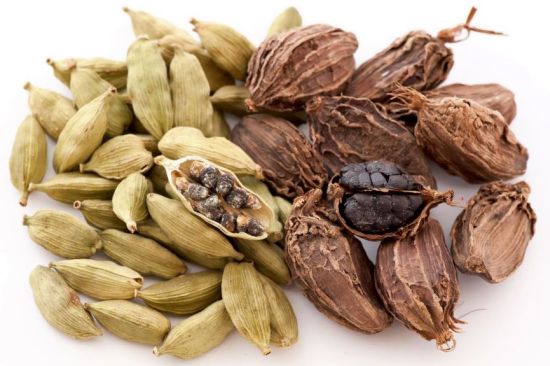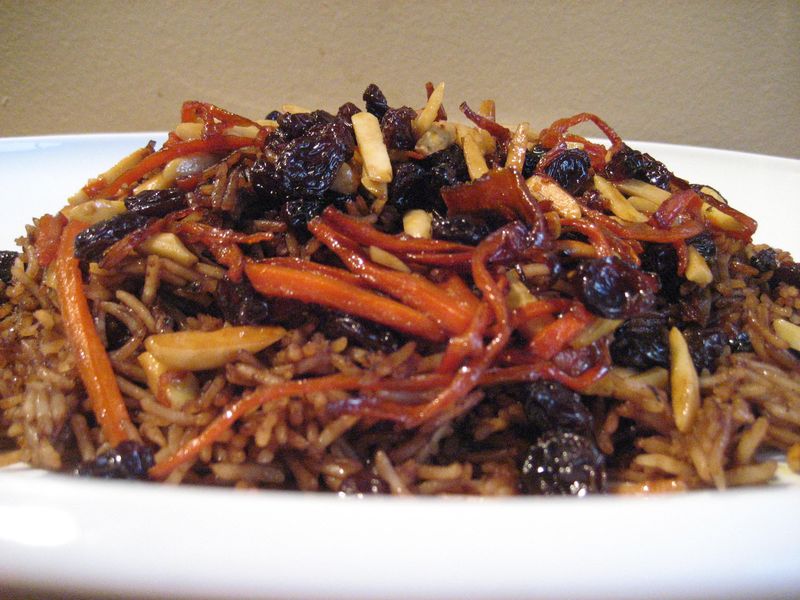Saveur Magazine Article
By Monica Bhide
When I was a child in Delhi, India, cardamom was as familiar as the air I breathed. Its sweet, woodsy perfume regularly filled the house when my parents were cooking. But it took me a while to appreciate the spice's flavor. "Too strong for me," I would say as I picked the pale green cardamom pods out of any rice dish or curry that was placed before me. It wasn't until I got a bit older and started drinking masala chai, India's ubiquitous brew of tea, milk, and spice, that I began to come around. Each Indian home has its own version, its own mix of flavoring spices. My father's chai was spiced only with cardamom, and plenty of it. He'd use a mortar and pestle to crush the pods and release their flavor before steeping them with the strong black tea. Perhaps it was the richness of the milk that made the difference: it seemed to both soften and deepen the flavor of the spice. All at once I was able to discern the cardamom's penetrating warmth and the way its complex flavor of pine, sweet musk, and bright citrus was awakened by the bitterness of the tea.
CupofTea
After my family moved from India to Bahrain, in the Persian Gulf, I discovered gahwa, the fragrant Arabic cardamom coffee, and loved nothing better than sipping it along with a square of cardamom-spiced baklava. It was Arab traders who first carried cardamom from India to Babylon, Egypt, Greece, and Rome, and today the Arab countries still consume more of it than any other place on earth.
It's still a precious commodity, too—nearly as costly as saffron and vanilla because, like them, it must be harvested by hand—and when I was a teenager, in our house as well as at our neighbors', serving cardamom to guests was understood as a gesture of respect. Often, that would mean producing an extravagantly spiced biryani made with nutty-tasting basmati rice, quite possibly the best vehicle for cardamom ever discovered. Sometimes, after a big meal, we'd follow my grandmother's custom and pass around cardamom pods to chew. In the ayurvedic system, cardamom is as much medicine as it is food; the same aromatic compounds that give the spice its flavor and warming properties also aid digestion.
As I began to spend more time in the kitchen, I learned that there is more than one type of cardamom and that each brings its own qualities to a dish. Green cardamom (Elettaria cardamomum), the most highly prized kind, is a bushy herb of the ginger family native to southwest India. It's cultivated extensively there and in Guatemala, now the world's largest exporter; Costa Rica, Tanzania, and Sri Lanka are the other top producers. The plants grow in clusters of slender stalks about 10 feet tall with large, lance-shaped leaves. The spice pods, which grow on shoots at the plant's base, are picked when they are just ripening and then dried under the sun or in a kiln. These small, oval pods and the tiny black seeds within contain the various compounds we experience as sweet, floral, and eucalyptus-like. That unique balance works as well in savory dishes as it does in sweet ones.
IMG_6193
Qabili Palau, Afghanistan's National Dish
Black cardamom (Amomum subulatum), a spice native to the Himalayas and cultivated today in Nepal, India, China, and Bhutan, has larger, deeply ridged pods that are dried over wood fires. As a result, the pods take on a dark brown color and a bold, smoky flavor that would overwhelm a sweet cake or pudding, but in a spice rub for roasted meat or in a full-flavored stew it imparts a smoldering depth no other spice can. Used together in a single dish, such as my family's chicken curry, green and black cardamom can harmonize beautifully. I've learned, too, about similarly fragrant relatives of cardamom, including delicate, floral Thai cardamom (see Expressions of Cardamom) and peppery West African grains of paradise.
CarrotHalwa
Afghan Cardamom Flavored Halwa
Since I moved to the United States 19 years ago, cardamom has been both a link to home and a bridge to other cuisines. The Scandinavians, it turns out, are second only to the Arabs in their hunger for cardamom, which the Vikings discovered in Constantinople a thousand years ago. Nordic cooks grasped early on that the fat-soluble spice blooms when baked in butter-laden sweets and breads. It's the keynote in the luscious Swedish cream puffs known as semlor and in Finland's yeast-risen, braided pulla bread, among many other baked treats.
AfghanBaklava
In the cooking classes I teach, I advise students to buy pods of green cardamom with a vibrant color and a strong fragrance; ones that are dull looking and shriveled will almost certainly have lost their flavor. The product labeled "white cardamom" is really just green cardamom that's been bleached for purely aesthetic reasons, and—to judge from the kinds I've tried—robbed of most of its taste and aroma. And since the flavor evaporates very quickly from the seeds once they're removed from the pod, and especially once they've been ground, it's best to buy the spice whole. If you want to cook with just the seeds—I like to fry them in oil to create a flavor base for all kinds of dishes—just use your fingers to pop open the pods and remove the seeds; keep the empty pods for steeping in coffee or tea. When I'm making desserts, I'll grind the seeds to a powder using a mortar and pestle or an electric spice grinder. As for black cardamom, it's almost always used whole and then discarded after cooking. I've never seen it for sale already ground.
I'm happy to say that my children have loved cardamom from the start. When I make the cardamom-spiced rice pudding called kheer, I tell them the story of how, once upon a time, I was a young engineering student who had just moved to the States. Everything was unfamiliar; nothing seemed to taste quite right. Finally, I borrowed ingredients from my neighbors and set about making my mother's kheer. When the milk, sugar, and rice began to simmer, I broke open a few pods of cardamom and dropped them into the pan; soon the kitchen began to radiate the spice's familiar scent. As I leaned over the stove to taste the kheer, the doorbell rang. Standing outside was a handsome young man who said he lived in the building next door. He was an MBA student from Mumbai; on his way to the library, he'd caught the scent of cardamom and, himself a little homesick, couldn't resist following it to its source. At this point my kids usually chime in. "That's when you met Daddy!" they cry, and my husband grins. Then we eat the kheer together, and the cardamom tastes just strong enough.
More Recipes on Afghan Culture Unveilved with Cardamom:
Afghan Creamy Tea, Qaymaq Chai
Afghan Cutter Cookies, Kulch-e- Birinjee
Cardamom Pudding With Pistachio
Related articles




















